Exhibitions
2015-2 MOMAT Collection
Date
-Location
Collection Gallery, from the fourth to second floors
Special exhibit
Foujita Tsuguharu: Complete Works from the Museum Collection (4th–2nd floor, room2-10)
The MOMAT Collection, a series of exhibits showcasing works from the holdings of the National Museum of Modern Art, Tokyo, has undergone drastic changes since it was revamped in 2012. The numerous, large-scale special exhibits have introduced a wealth of outstanding works and received a great deal of acclaim from viewers.
This year, the 70th anniversary of the end of World War II, we present a total of 26 works, consisting of 25 works (the museum’s entire collection) by Foujita Tsuguharu and one special addition, in an approximately 1,500-square-meter area beginning on the fourth floor of the museum and continuing on the third floor.
The exhibit marks the first time that all 14 of Foujita’s war paintings have been shown at once. It is notable for an invaluable film directed by the artist that will be on constant view in the gallery. Using other resources such as illustrated books from Foujita’s own collection and magazines from the period containing his statements, the exhibit will examine the artist’s career from a variety of different angles.
How did Foujita succeed as an artists in Paris in the 1920s? Why did he start making war paintings after returning to Japan? What was he thinking when he went back to France after the war? There are still a multitude of questions regarding Foujita that remained unanswered.
Experience the allure and magic of Foujita’s work, and the power of the MOMAT Collection at the National Museum of Modern Art, Tokyo this autumn.
About the section of Special exhibit
About the Prohibition of Photography in the Collection Galleries and the Suspension of the Audio Guide
During the period from September 19 to December 13, 2015, no photography is allowed in the Collection Galleries and Gallery 4 because congestion is expected.
No Audio Guide is available during the period.
4th Floor
Room 3 A Stranger in Paris
In this room, we present a group of works dating from Foujita’s arrival in Paris at the age of 27 in 1913 until he achieved great success there in the 1920s.
Stimulated by the city, Foujita experimented with a variety of styles, and after enduring many hardships, emerged as a prominent figure in the art world in 1919.
His reputation in the ’20s rested on his depictions of nude women and cats, made by applying ink-black lines to a moist, delustered foundation known as “milky-white skin.” After considering how to best evoke the exotic charms associated with Japanese people in a foreign land, Foujita devised this approach by referring to ukiyo-e (woodblock prints) and other works.
Room 5 Return to Japan
In 1931, partly due to the effects of the Great Depression, Foujita left France and set out on a trip to South America that lasted about two years.
Before leaving Paris, Foujita had made an epic work depicting a tangle of robust nude bodies as part of his search for a new style. On his travels, he was apparently influenced by the Mexican Muralist Movement, which attempted to appeal to the masses with expansive pictures.
In 1933, Foujita returned to Japan. Though he had already enjoyed spectacular success in Paris for the better part of a decade, Foujita met with an unexpectedly chilly reception when he revisited the Japanese art scene for the first time in a long time.
When the Sino-Japanese War broke out in 1937, Foujita was commissioned by the Imperial Army and Navy to gather material for his work on the battlefront. This marked the start of his war paintings.
3th Floor
Room 6 War Paintings
The Pacific War began in 1941. As Foujita had in the Sino-Japanese War, he continued making pictures based on material he gathered on the front lines. These early efforts, however, were rather stiff.
Around 1942, he resolutely devoted himself to the idea that “subjectivity should be freely blended into a picture,” and began making dramatic works modeled on European masterpieces. To Foujita, who admired great painters like Leonardo da Vinci, Michelangelo and Raffaello, this was an excellent opportunity to study such works.
His detailed, close-up depiction of a fierce battle, which he would never actually have been able to see, in Final Fighting on Attu earned him a great deal of attention. Young artists who found it hard to depict the subject of war also began to request Foujita’s guidance.
Room 8 After the War
Japan’s war efforts had begin to take a turn for the worse. Following the 1943 attack on Attu Island, the military authorities announced that the battle had been lost while imparting every citizen to fight to the end.
From Final Fighting on Attu until Compatriots on Saipan Island Remain Faithful to the End, dealing with the last stage of the war, Foujita’s war paintings shifted from a focus on victorious battles to the graphic depiction of Japanese soldiers’ deaths.
Japan was defeated in 1945. This time Foujita was commissioned by the General Headquarters of the Allied Powers to hand over Japanese war paintings to the Americans. Around the same time, he was apparently persuaded by friends in the Japanese art world to accept responsibility for cooperating with the wartime administration.
In 1949, Foujta left Japan at the age of 63. In 1955, he became a French citizen, never to return to his homeland again.
Room 9 Beautiful Books
From the time he moved to Paris, Foujita became involved in designing books. These included a wide range of publications, from sumptuous tomes dedicated to an artist’s work to inexpensive books. Foujita also wrote an introduction to Japanese culture that was published in France, and published several collections of essays based on his recollections of Paris in Japan, including Profile of Paris (1929), A Self-Made Man (1936), Collected Essays: Swimming on Land (1942), and Day and Night in Paris (1948).
In 2007, Foujita’s widow, Kimiyo, donated approximately 900 documents from the artist’s estate to the National Museum of Modern Art, Tokyo. The displays in this room are drawn from those materials. You will find more of them in Room 2.
About the Sections
MOMAT Collection comprises twelve(or thirteen)rooms and two spaces for relaxation on three floors. In addition, sculptures are shown near the terrace on the second floor and in the front yard. The light blue areas in the cross section above make up MOMAT Collection. The space for relaxation A Room With a View is on the fourth floor.
The entrance of the collection exhibition MOMAT Collection is on the fourth floor. Please take the elevator or walk up stairs to the fourth floor from the entrance hall on the first floor.
4F (Fourth floor)
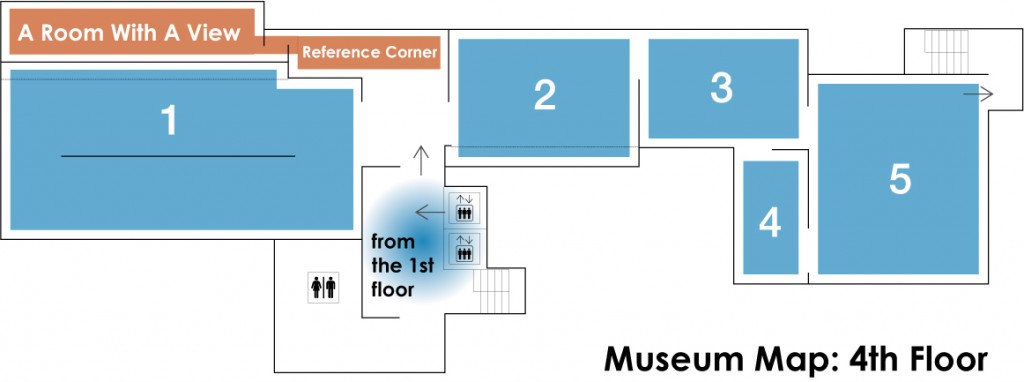
Room 1 Highlights * This section presents a consolidation of splendid works from the collection, with a focus on Master Pieces.
Room 2– 5 1900s-1940s
From the End of the Meiji Period to the Beginning of the Showa Period
A Room With A View
Reference Corner
1. Room 1 Highlights
Over 200 works are lined up in this 3,000-square-meter space — these extravagant conditions are the selling point of the MOMAT Collection. But in recent years, we have received an increasing number of comments like, “They’re so many things here, I’m not sure what to see!” and “All I want to do is have a quick look at the famous works in a short period of time!” Thus, as part of the gallery renovation that was undertaken in the summer of 2012, we have created this “Highlights” corner to allow visitors to enjoy a consolidation of splendid works from the collection, with a focus on Important Cultural Properties.
In this section, devoted to Nihon-ga (Japanese-style painting), we present Hayami Gyoshu’s Houses in Kyoto, Houses in Nara for the second time since the work was acquired by the museum two years ago.
Other highlights include Murakami Kagaku’s Kiyohime at the Hidaka River, an Important Cultural Property which will be on view during the first half of the exhibit (until Oct. 25), and Kawai Gyokudo’s Autumn Rain, an emotional depiction of changing leaves in late autumn, which will be on view during
the second half of the exhibit (from Oct. 27). in addition to Important Cultural Properties by artists such as Harada Naojiro, Yorozu Tetsugoro, and Kishida Ryusei, who have become staples of the “Highlights” section, the oil-painting exhibit includes works like Wada Sanzo’s South Wind and Migishi Kotaro’s Butterflies Flying above Clouds. Along with these paintings, you can enjoy a sampling of works by foreign artists such as Henri Rousseau and Oskar Kokoschka.
Room 2 to Room 5 Special exhibit Foujita Tsuguharu: Complete Works from the Museum Collection
During this period, Rooms 2 to 5 are used for the special exhibit Foujita Tsuguharu: All of His Works in the Museum’s Collection. For details, please see Highlights.
3F (Third floor)
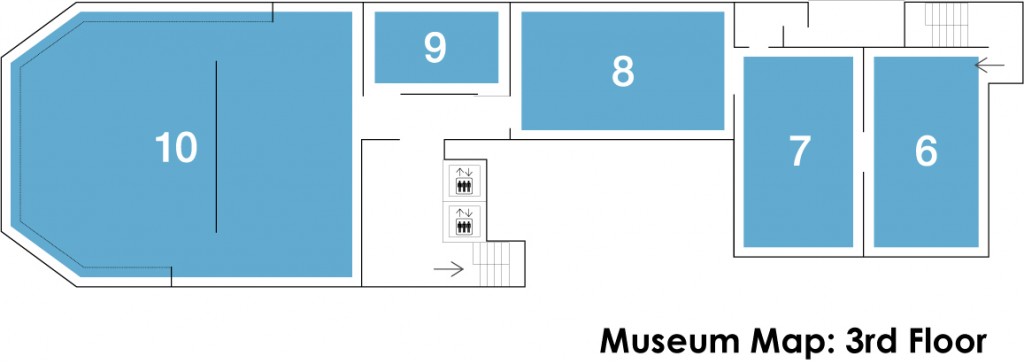
Room 6-8 1940s-1960s
From the End of the Meiji Period to the Beginning of the Showa Period
Room 9 Photography and Video
Room 10 Nihon-ga (Japanese-style Painting)
Room to Consider the Building
10. Room 10 The War Experiences of Ai-Mitsu, Yamashita Kikuji, and Higashiyama Kaii
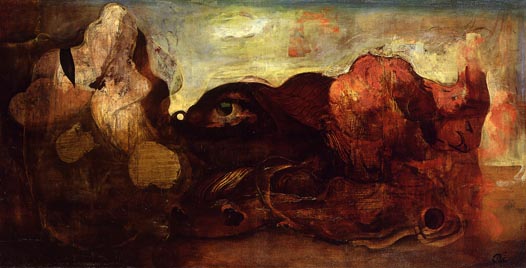
In the special exhibit Foujita Tsuguharu: Complete Works from the Museum Collection, we examine the connection between art and war through the work of a single artist. In this room, we present a group of works made between the 1930s and the 1950s by Ai-Mitsu, Yamashita Kikuji, and Higashiyama Kaii as other examples of artists who sublimated their war experiences in painting.
To begin with, there is a TV program from 1980 of Yamashita discussing Ai-Mitsu’s work. While serving as an homage to the artist, Yamashita’s unique interpretation of Landscape with an Eye and Self-Portrait also provides insight into his own view of painting. He apparently believed that an artist’s ideas, cultivated under extreme conditions, are impossible to illustrate, and dwell in the enigmatic, allusive power of images that are supported by the materiality of a painting. Meanwhile, in an essay titled “Nature and Me,” Higashiyama wrote, “In the middle of the war, I had an experience in which my mind’s eye opened to the landscape.” He also confessed, “At that time, I came to realize that the fire of my life was on the verge of being extinguished,” but a regular natural landscape “caught my eye because it was so full of life.” This led to the birth of the highly abstract symbolism that characterized Higashiyama’s approach to landscape painting.
2F (Second floor)
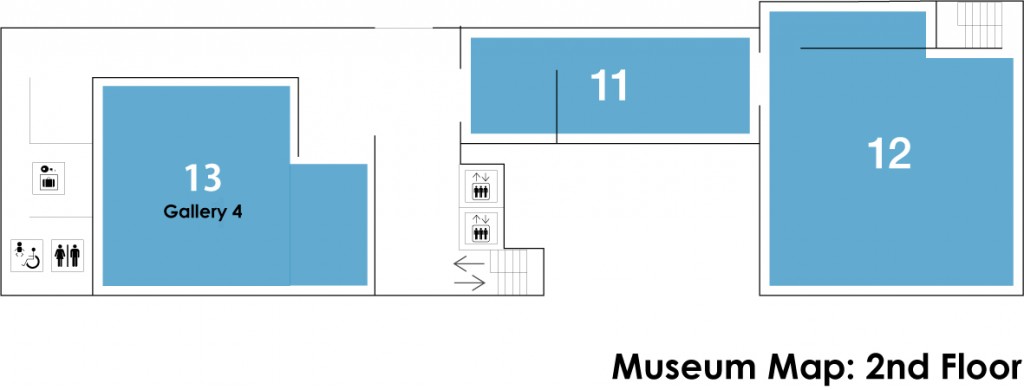
Room 11-12 1970s-2010s
From the End of the Showa Period to the Present
Gallery 4 glove|evolg,
Primarily from the Museum Collection
* A space of about 250 square meters. This gallery offers cutting-edge thematic exhibitions from the Museum Collection, and special exhibitions featuring photographs or design.
11. Room 11 What is techne for?
Though the word “technique” is derived from the Greek term techne, its Latin translation, ars, is the root of “art.” This suggests that the general assumption that an art work is made by a human being who modifies a material is connected to this etymology. (Incidentally, human agency is not necessarily a prerequisite for beauty – see, for example, natural beauty.)
It is perhaps inevitable then that contemporary artists are interested in the ultimate technical conditions. One uses computer-controlled machinery to create scenes in stainless steel that are so precise they could never have been made by hand. Another suggests that nuclear tests, which in a sense can be seen as the apex of technology, have quietly crept into an art work due to their innocent appearance. And still another artist attempted to get as close as possible to the nuclear reactor in Fukushima, the site of the accident that might be considered the “defeat of Japanese scientific technology.”
12. Room 12 A Meandering 60-year Journey
Usually, the MOMAT Collection presents works and documents primarily related to Japanese art that are arranged in roughly chronological order in 12 rooms, each with a specific theme, beginning on the fourth floor and continuing on the next two floors. But in this edition almost all of the rooms are being used to show works by Foujita Tsuguharu. As a result, we have attempted to introduce a group
of works created over a 60-year period, from the 1940s to the 2000s, in a single room.
The works are basically arranged chronologically, but there is really no way to convey all of the changes that have occurred in Japanese art. What can be said, however, is that everything here really was made over a 60-year period. We hope that while imagining the invisible flow of time, you will stop for a while in front of the works that catch your eye and think about their relationship with each era, and how they are connected or disconnected from what came before or after (or to the left and right) of them. For example, you might consider how the ground was perceived after the war or how photographic expression changed in the ’70s and ’80s. Two of these artists, Yamanaka Nobuo and Muraoka Saburo, are also included in the special exhibition on the first floor, which runs from Oct. 6 to Dec. 13.
Important Cultural Properties on display
About the Prohibition of Photography in the Collection Galleries and the Suspension of the Audio Guide
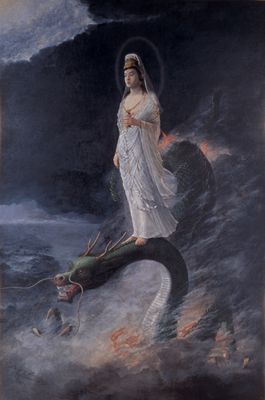
1890 (Longtime loan;coll. Gokokuji Temple)
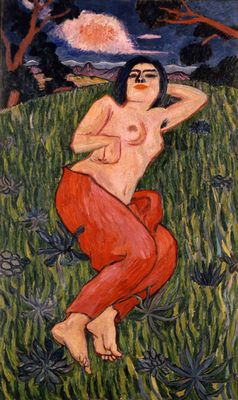
During the period from September 19 to December 13, 2015, no photography is allowed in the Collection Galleries and Gallery 4 because congestion is expected.
No Audio Guide is available during the period.
The collection at the main building of the National Museum of Modern Art, Tokyo now has thirteen pieces that are designated as Important Cultural Properties by the Japanese government, comprising eight Japanese-style paintings, four oil paintings and one sculpture.
The following Important Cultural Properties are shown in this period:
- Harada Naojiro,Kannon Bodhisattva Riding the Dragon,1890 (Longtime loan;coll. Gokokuji Temple)
- Yorozu Tetsugoro, Nude Beauty, 1912
- Kishida Ryusei, Road Cut through a Hill, 1915
- Murakami Kagaku, Kiyohime at the Hidaka River , 1919【Shown only in the first phase of the exhibit:September 19 – October 25, 2015】
Please visit the Important Cultural Property section Masterpieces for more information about the pieces.
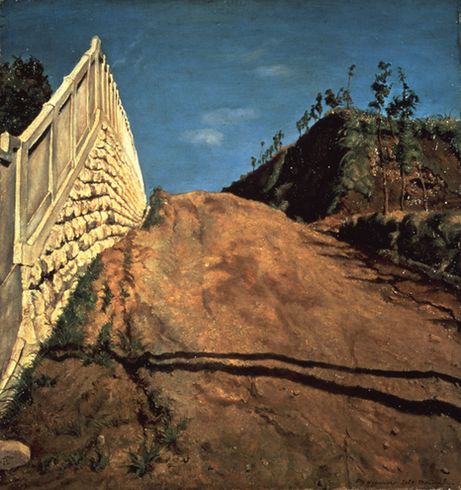
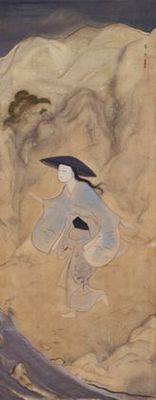
About the Exhibition
- Location
-
Collection Gallery, from the fourth to second floors
- Date
-
September 19, 2015 – December 13, 2015
- Time
-
10:00 – 17:00
*Last admission is 30 minutes before closing. - Closed
-
※Closed on Mondays (except September 21, October 12, November 23) , September 24, October13, and November 24
- Admission
-
Adults ¥430 (220)
College and university students ¥130 (70)*Including the admission fee for MOMAT Collection and glove|evolg. *The price in brackets is for the group of 20 persons or more.
*All prices include tax.
*Free for high school students, under 18, seniors(65 and over), Campus Members, MOMAT passport holder.
*Show your Membership Card of the MOMAT Supporters or the MOMAT Members to get free admission (a MOMAT Member’s Card admits two persons free).
*Persons with disability and one person accompanying them are admitted free of charge. - Free Admission Days
-
*Collection Gallery and Gallery 4
Free on October 4, November 1, November 3 and December 6 - Organized by
-
The National Museum of Modern Art, Tokyo
About the Prohibition of Photography in the Collection Galleries and the Suspension of the Audio Guide
During the period from September 19 to December 13, 2015, no photography is allowed in the Collection Galleries and Gallery 4 because congestion is expected.
No Audio Guide is available during the period.


